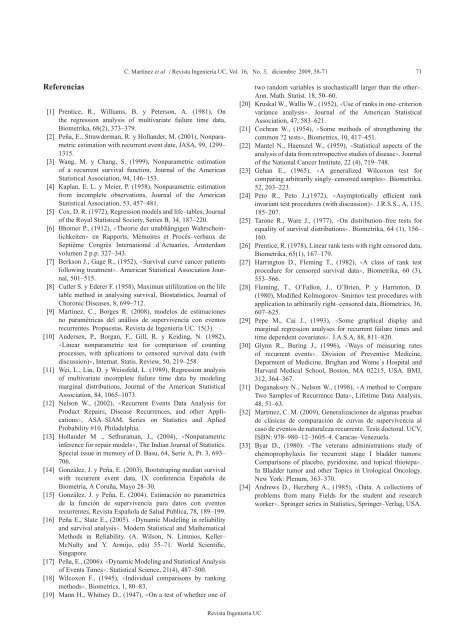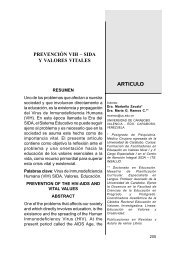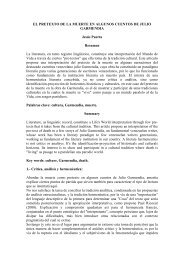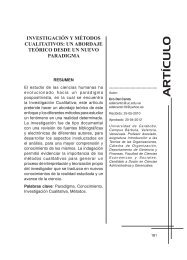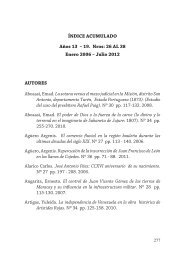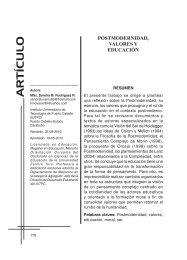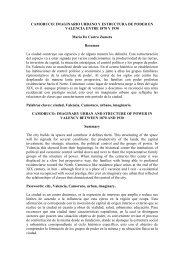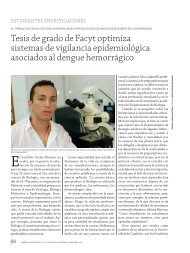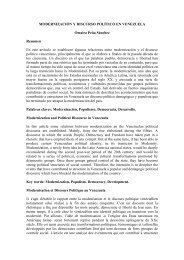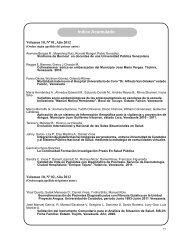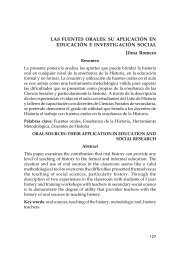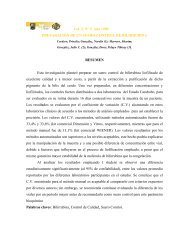Pruebas no paramétricas para comparar curvas de supervivencia ...
Pruebas no paramétricas para comparar curvas de supervivencia ...
Pruebas no paramétricas para comparar curvas de supervivencia ...
Create successful ePaper yourself
Turn your PDF publications into a flip-book with our unique Google optimized e-Paper software.
C. Martínez et al / Revista Ingeniería UC, Vol. 16, No. 3, diciembre 2009, 58-71 71Referencias[1] Prentice, R., Williams, B. y Peterson, A. (1981), Onthe regression analysis of multivariate failure time data,Biometrika, 68(2), 373–379.[2] Peña, E., Straw<strong>de</strong>rman, R. y Hollan<strong>de</strong>r, M. (2001), Non<strong>para</strong>metricestimation with recurrent event date, JASA, 99, 1299–1315.[3] Wang, M. y Chang, S. (1999), Non<strong>para</strong>metric estimatio<strong>no</strong>f a recurrent survival function, Journal of the AmericanStatistical Association, 94, 146–153.[4] Kaplan, E. L. y Meier, P. (1958), Non<strong>para</strong>metric estimationfrom incomplete observations, Journal of the AmericanStatistical Association, 53, 457–481.[5] Cox, D. R. (1972), Regression mo<strong>de</strong>ls and life–tables, Journalof the Royal Statistical Society, Series B, 34, 187–220.[6] Bhomer P., (1912), ✭✭Theorie <strong>de</strong>r unabhängigen Wahrscheinlichkeiten✮✮en Rapports, Mémoires et Procès–verbaux <strong>de</strong>Septième Congrès International d´Áctuaries, Ámsterdamvolumen 2 p.p. 327–343.[7] Berkson J., Gage R., (1952), ✭✭Survival curve cancer patientsfollowing treatment✮✮. American Statistical Association Journal,501–515.[8] Cutler S. y E<strong>de</strong>rer F. (1958), Maximun utililization on the lifetable method in analysing survival, Biostatistics, Journal ofChoronic Diseases, 8, 699–712.[9] Martínez, C., Borges R. (2008), mo<strong>de</strong>los <strong>de</strong> estimaciones<strong>no</strong> <strong>para</strong>métricas <strong>de</strong>l análisis <strong>de</strong> <strong>supervivencia</strong> con eventosrecurrentes. Propuestas. Revista <strong>de</strong> Ingeniería UC. 15(3).[10] An<strong>de</strong>rsen, P., Borgan, F., Gill, R. y Keiding, N. (1982),✭✭Linear <strong>no</strong>n<strong>para</strong>metric test for comparison of countingprocesses, with aplications to censored survival data (withdiscussion)✮✮, Internat. Statis. Review, 50, 219–258.[11] Wei, L., Lin, D. y Weissfeld, L. (1989), Regression analysisof multivariate incomplete failure time data by mo<strong>de</strong>lingmarginal distributions, Journal of the American StatisticalAssociation, 84, 1065–1073.[12] Nelson W., (2002), ✭✭Recurrent Events Data Analysis forProduct Repairs, Disease Recurrences, and other Applications✮✮,ASA–SIAM, Series on Statistics and ApliedProbability #10, Phila<strong>de</strong>lphia.[13] Hollan<strong>de</strong>r M ., Sethuraman, J., (2004), ✭✭Non<strong>para</strong>metricinference for repair mo<strong>de</strong>ls✮✮, The Indian Journal of Statistics.Special issue in memory of D. Basu, 64, Serie A, Pt. 3, 693–706.[14] González, J. y Peña, E. (2003), Bootstraping median survivalwith recurrent event data, IX conferencia Española <strong>de</strong>Biometría, A Coruña, Mayo 28–30.[15] González, J. y Peña, E. (2004), Estimación <strong>no</strong> <strong>para</strong>metrica<strong>de</strong> la función <strong>de</strong> <strong>supervivencia</strong> <strong>para</strong> datos con eventosrecurrentes, Revista Española <strong>de</strong> Salud Pública, 78, 189–199.[16] Peña E., Slate E., (2005). ✭✭Dynamic Mo<strong>de</strong>ling in reliabilityand survival analysis✮✮. Mo<strong>de</strong>rn Statistical and MathematicalMethods in Reliability. (A. Wilson, N. Limnios, Keller–McNulty and Y. Armijo, eds) 55–71. World Scientific,Singapore.[17] Peña, E., (2006). ✭✭Dynamic Mo<strong>de</strong>ling and Statistical Analysisof Events Times✮✮. Statistical Science, 21(4), 487–500.[18] Wilcoxon F., (1945), ✭✭Individual comparisons by rankingmethods✮✮. Biometrics, 1, 80–83.[19] Mann H., Whitney D., (1947), ✭✭On a test of whether one oftwo random variables is stochasticalll larger than the other✮✮.Ann. Math. Statist. 18, 50–60.[20] Kruskal W., Wallis W., (1952), ✭✭Use of ranks in one–criterionvariance analysis✮✮. Journal of the American StatisticalAssociation, 47, 583–621.[21] Cochran W., (1954), ✭✭Some methods of strengthening thecommon ?2 tests✮✮, Biometrics, 10, 417–451.[22] Mantel N., Haenszel W., (1959), ✭✭Statistical aspects of theanalysis of data from retrospective studies of disease✮✮. Journalof the National Cancer Institute, 22 (4), 719–748.[23] Gehan E., (1965), ✭✭A generalized Wilcoxon test forcomparing arbitrarily singly–censored samples✮✮. Biometrika,52, 203–223.[24] Peto R., Peto J.,(1972), ✭✭Asymptotically efficient rankinvariant test procedures (with discussion)✮✮. J.R.S.S., A, 135,185–207.[25] Tarone R., Ware J., (1977), ✭✭On distribution–free tests forequality of survival distributions✮✮. Biometrika, 64 (1), 156–160.[26] Prentice, R. (1978), Linear rank tests with right censored data,Biometrika, 65(1), 167–179.[27] Harrington D., Fleming T., (1982), ✭✭A class of rank testprocedure for censored survival data✮✮, Biometrika, 60 (3),553–566.[28] Fleming, T., O’Fallon, J., O’Brien, P. y Harrinton, D.(1980), Modified Kolmogorov–Smir<strong>no</strong>v test procedures withapplication to arbitrarily right–censored data, Biometrics, 36,607–625.[29] Pepe M., Cai J., (1993), ✭✭Some graphical display andmarginal regression analyses for recurrent failure times andtime <strong>de</strong>pen<strong>de</strong>nt covariates✮✮. J.A.S.A, 88, 811–820.[30] Glynn R., Buring J., (1996), ✭✭Ways of measuring ratesof recurrent events✮✮. Division of Preventive Medicine,Deparment of Medicine, Brighan and Wome´s Hospital andHarvard Medical School, Boston, MA 02215, USA. BMJ,312, 364–367.[31] Doganaksoy N., Nelson W., (1998), ✭✭A method to CompareTwo Samples of Recurrence Data✮✮, Lifetime Data Analysis,48, 51–63.[32] Martínez, C. M. (2009), Generalizaciones <strong>de</strong> algunas pruebas<strong>de</strong> clásicas <strong>de</strong> com<strong>para</strong>ción <strong>de</strong> <strong>curvas</strong> <strong>de</strong> <strong>supervivencia</strong> alcaso <strong>de</strong> eventos <strong>de</strong> naturaleza recurrente. Tesis doctoral. UCV,ISBN: 978–980–12–3605–4. Caracas–Venezuela.[33] Byar D., (1980): ✭✭The veterans administrations study ofchemoprophylaxis for recurrent stage I blad<strong>de</strong>r tumors:Comparisons of placebo, pyridoxine, and topical thiotepa✮✮.In Blad<strong>de</strong>r tumor and other Topics in Urological Oncology.New York: Plenum, 363–370.[34] Andrews D., Herzberg A., (1985), ✭✭Data. A collections ofproblems from many Fields for the stu<strong>de</strong>nt and researchworker✮✮. Springer series in Statistics, Springer–Verlag, USA.Revista Ingeniería UC


